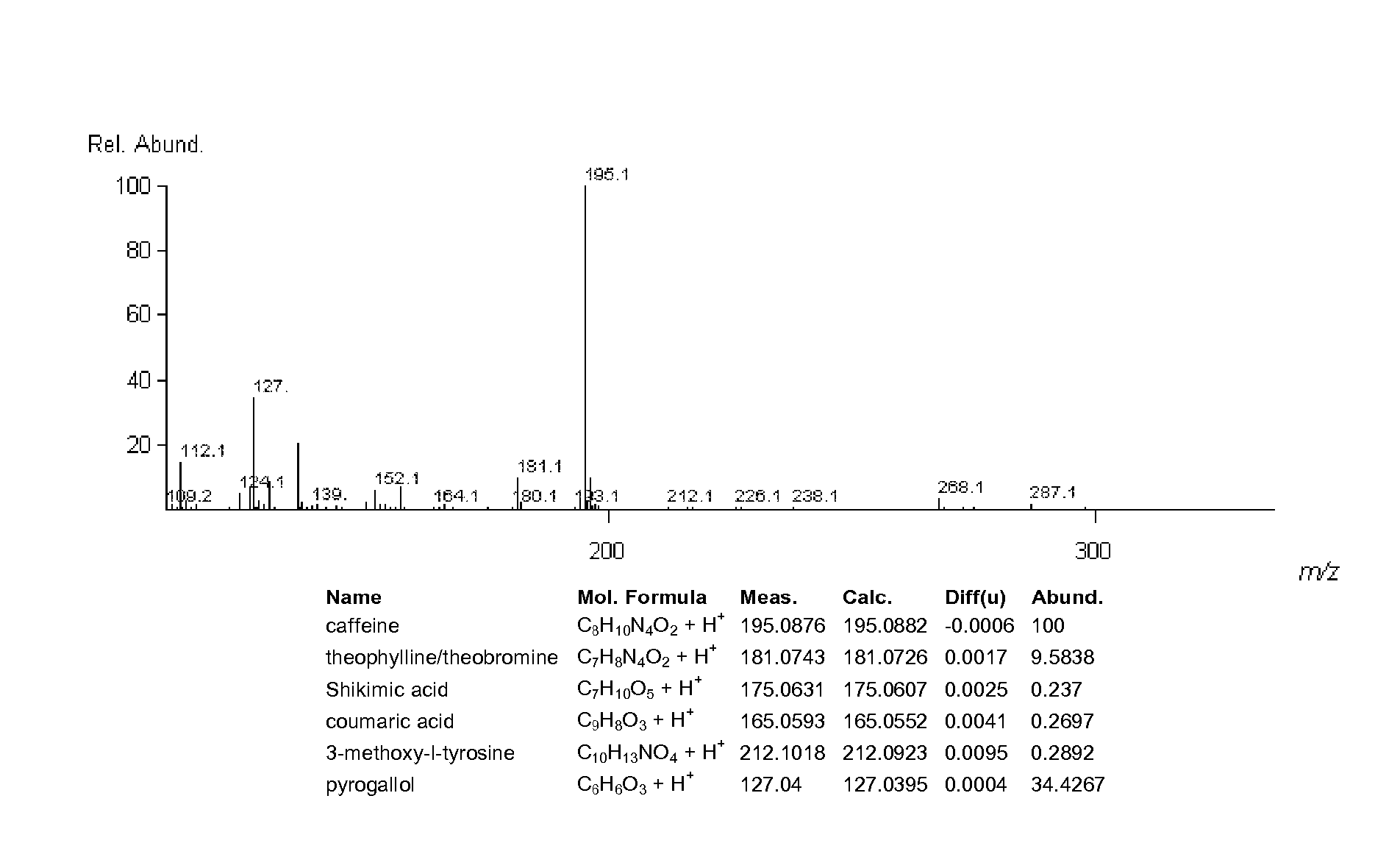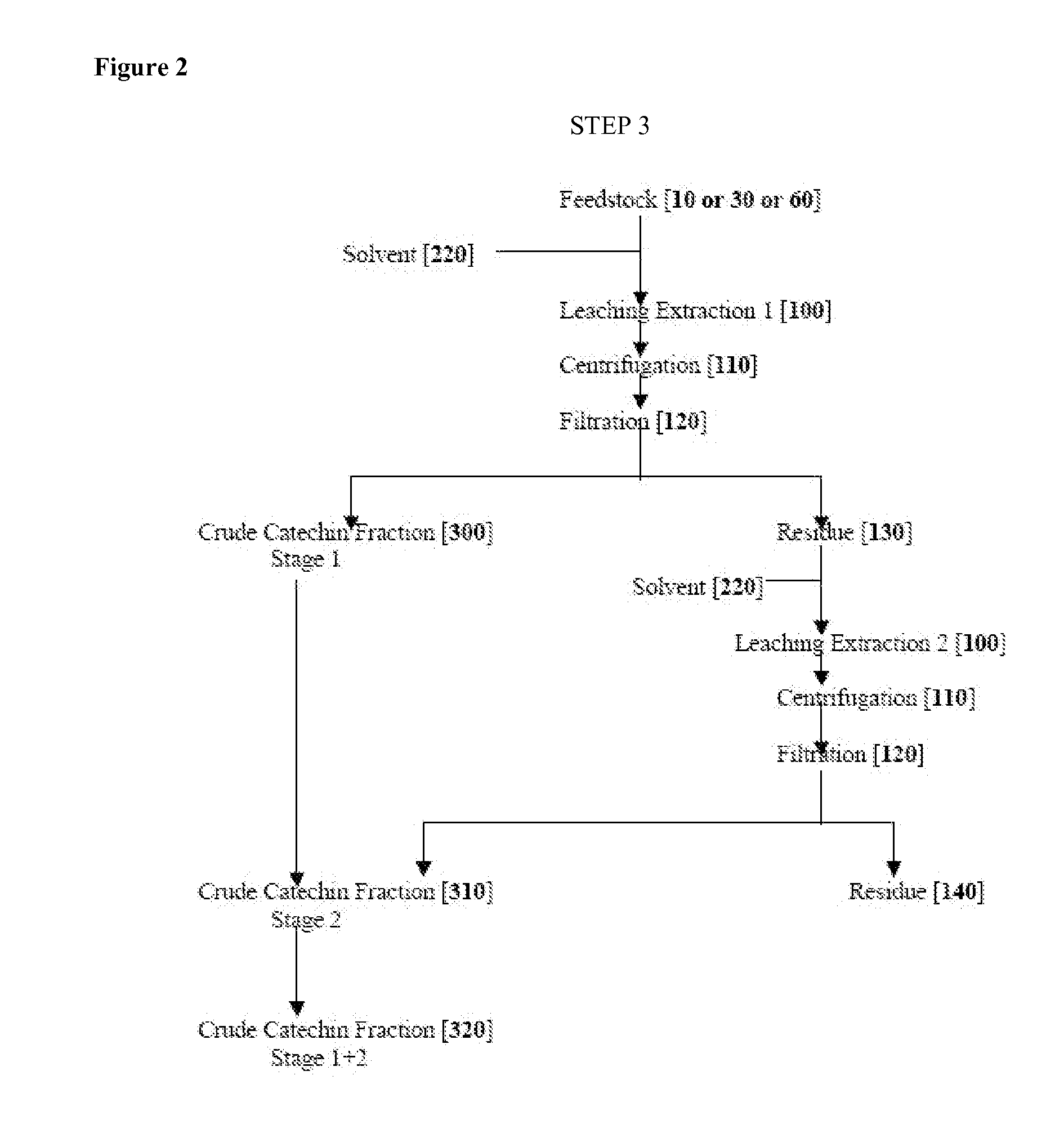Extracts and Methods Comprising Green Tea Species
a technology of green tea and extracts, applied in tea extraction, instruments, biocide, etc., can solve the problems of increased blood pressure, excessive consumption of caffeine, and exaggeration of stress and stress-related hormone release, and achieve the effect of greatest biologically beneficial activity
- Summary
- Abstract
- Description
- Claims
- Application Information
AI Technical Summary
Benefits of technology
Problems solved by technology
Method used
Image
Examples
example 1
Example of Step 1
Single Step SFE Extraction and Purification of Green Tea Essential Oil
[0163] All SFE extractions were performed on SFT 250 (Supercritical Fluid Technologies, Inc., Newark, Del., USA) designed for pressures and temperatures up to 690 bar and 200° C., respectively. This apparatus allows simple and efficient extractions at supercritical conditions with flexibility to operate in either a dynamic or static mode. This device consists of three modules: an oven, a pump and control and a collection module. The oven has one preheat column and one 100 ml extraction vessel. The pump module is equipped with a compressed air-driven pump with constant flow capacity of 300 ml / min. The collection module is a glass vial of 40 ml, sealed with caps and septa for the recovery of extracted products. It is further provided with micrometer valves and a flow meter. Extraction vessel pressure and temperature are monitored and controlled within + / −3 bar and + / −1° C.
[0164] In a typical exper...
example 2
Example of Step 2
Single Step SFE Decaffeination of Green Tea Plant Material
[0166] All SFE extractions were performed on SFT 250 (Supercritical Fluid Technologies, Inc., Newark, Del., USA). In a typical experimental example, the residue of the 25 grams of the essential oil extracted tea cut green tea leaves wet with 25 gm of distilled water co-solvent was loaded into a 100 ml extraction vessels for each experiment. The oven was preheated to the desired temperature before the packed vessel was loaded. After the vessel was connected into the oven, the extraction system was tested for leakage by pressurizing the system with CO2 (850 psig), and purged. The system was closed and pressurized to desired extraction pressure using the air-driven liquid pump. The system was then left for equilibrium for ˜3 min. A sampling vial (40 ml) was weighed and connected to the sampling port. The extraction was started by flowing CO2 at a rate of 5 SLPM (9.8 g / min), which is controlled by a meter valve....
example 3
Example of Step 3
95% Ethanol Leaching Extraction
[0167] Typical examples of 2 stage solvent extractions of the catechin chemical constituents of green tea leaf material is as follows: The feedstock was 25 gm of tea cut green tea leaf SFE residue from Step 2 SCCO2 decaffeination or raw green tea leaf feedstock. The solvent was 250 ml of 95% ethanol. In this method, the feedstock material and 250 ml 95% ethanol were separately loaded into 500 ml extraction vessel and mixed in a heated water bath at 70° C. for 2 hours. The extraction solution was filtered using Fisherbrand P4 filter paper having a particle retention size of 4-8 μm, centrifuged at 3000 rpm for 20 minutes, and the particulate residue used for further extraction. The filtrate (supernatant) was collected for yield calculation and HPLC analysis. The residue of Stage 1 was extracted for 2 hours (Stage 2) using the aforementioned methods. The supernatant extracts were combined and the ethanol removed using a rotary evaporator...
PUM
 Login to View More
Login to View More Abstract
Description
Claims
Application Information
 Login to View More
Login to View More - R&D
- Intellectual Property
- Life Sciences
- Materials
- Tech Scout
- Unparalleled Data Quality
- Higher Quality Content
- 60% Fewer Hallucinations
Browse by: Latest US Patents, China's latest patents, Technical Efficacy Thesaurus, Application Domain, Technology Topic, Popular Technical Reports.
© 2025 PatSnap. All rights reserved.Legal|Privacy policy|Modern Slavery Act Transparency Statement|Sitemap|About US| Contact US: help@patsnap.com



